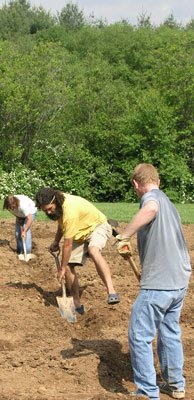Super-sized Cassava Plants May Help Fight Hunger in Africa

 In a recent study, genetically modified cassava plants produced roots that were more than two-and-a-half times the size of normal cassava roots.The findings could help ease hunger in many countries where people rely heavily on the cassava plant (Manihot esculenta) as a primary food source, said Richard Sayre, the study's lead author and a professor of plant cellular and molecular biology at Ohio State University.
In a recent study, genetically modified cassava plants produced roots that were more than two-and-a-half times the size of normal cassava roots.The findings could help ease hunger in many countries where people rely heavily on the cassava plant (Manihot esculenta) as a primary food source, said Richard Sayre, the study's lead author and a professor of plant cellular and molecular biology at Ohio State University. The researchers used a gene from the bacterium E. coli to genetically modify cassava plants. The plants, which were grown in a greenhouse, produced roots that were an average of 2.6 times larger than those produced by regular cassava plants.
“Not only did these plants produce larger roots, but the whole plant was bigger and had more leaves,” Sayre said. Both the roots and leaves of the cassava plant are edible.
Cassava is the primary food source for more than 250 million Africans – about 40 percent of the continent's population. And the plant's starchy tuberous root is a substantial portion of the diet of nearly 600 million people worldwide.
Sayre said he hopes to offer these plants to countries where cassava is an important crop.
The current study appears in the online early issue of the Plant Biotechnology Journal. Sayre collaborated with Ohio State colleague Uzoma Ihemere and scientists from BASF Plant Science in Research Triangle Park, N.C., and BARC-West in Beltsville, Md., who formerly worked on this project in his laboratory.
Sayre said that cassava produces sugar more efficiently than any other cultivated plant.
“We wanted to find a way to help the plant redirect that excess sugar and use it to make starch,” Sayre said.
The researchers used a variety of cassava native to Colombia (cassava was brought to Africa from South America by the Portuguese in the 1500s.) They inserted into three cassava plants an E. coli gene that controls starch production. A non-modified fourth plant served as a control.
“Cassava actually has this same gene,” Sayre said. “But the bacterial version of the gene is about a hundred times more active.”
The modified plants converted more of their sugar into starch, as shown by an increase in root size as well as the number of roots and leaves produced by each modified plant.
The roots of the modified plants were up to 2.6 fold larger than the roots of a non-modified plant (an average of 198 grams for the biggest roots vs. 74 grams for the roots of the non-modified plant.) The modified plants produced a maximum of 12 roots, compared to the seven roots produced by the non-modified plant. These modified plants also produced a third more leaves – a maximum of 123 leaves per modified plant vs. 92 leaves per non-modified plant.
Sayre said that the bigger roots produced by the plants were just that – bigger. They weren't necessarily more nutritious. And they would still need to be processed quickly and properly after harvesting, as the roots and leaves of poorly processed cassava plants contain a substance that triggers the production of cyanide.
In previous work, Sayre helped create cassava that produced little to no cyanide once it is harvested.
He is also the principal investigator of an ongoing project focused on improving the nutritional content of cassava. In this work Sayre leads a team of national and international scientists focused on increasing the vitamin, mineral and protein content of the plant.
The current study was supported in part by the Rockefeller Foundation, the Centro Internacional Agricultura Tropical (CIAT) and Ohio State.
Source: http://www.sciencedaily.com/releases/2006/05/060524221812.htm














